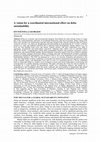Papers by Marcel Marchand
Handbook of Hazards and Disaster Risk Reduction, 2014

Deltas are economic and environmental hotspots, food baskets for many nations, home to a large pa... more Deltas are economic and environmental hotspots, food baskets for many nations, home to a large part of the world population, and hosts of exceptional biodiversity and rich ecosystems. Deltas, being at the land-water interface, are international, regional, and local transport hubs, thus providing the basis for intense economic activities. Yet, deltas are disappearing and deteriorating at an alarming rate as "victims" of human actions (e.g. water and sediment reduction due to upstream basin development), climatic impacts (e.g. sea level rise and flooding from rivers and intense tropical storms), and local exploration (e.g. sand or aggregates, groundwater and hydrocarbon extraction). Although many efforts exist on individual deltas around the world, a comprehensive global delta sustainability initiative that promotes awareness, science integration, data and knowledge sharing, and development of decision support tools for an effective dialogue between scientists, managers and policy makers is lacking. Recently, the international scientific community proposed to establish the International Year of Deltas (IYD) to serve as the beginning of such a Global Delta Sustainability Initiative. The IYD was proposed as a year to: (1) increase awareness and attention to the value and vulnerability of deltas worldwide; (2) promote and enhance international and regional cooperation at the scientific, policy, and stakeholder level; and (3) serve as a launching pad for a 10-year committed effort to understand deltas as complex socio-ecological systems and ensure preparedness in protecting and restoring them in a rapidly changing environment. This paper articulates the vision for such an initiative as developed by a large number of international experts (see contributing authors) and pleads for a comprehensive and coordinated effort that spans continents and environments to demonstrate that indeed these "hot spots of vulnerability and change" can become again "seedbeds of sustainability and resilience."

Built Environment, 2014
ABSTRACT During French colonial times, the Mekong Delta was provided with an extensive network of... more ABSTRACT During French colonial times, the Mekong Delta was provided with an extensive network of canals and its urban pattern is strongly related to this network. The network has contributed to the development of the delta, which is currently one of the largest rice production areas in the world. Flooding is still an annual event over large parts of the delta. It brings new sediments and nutrients to the fields, benefiting both the rice production and the long-term sustainability of the delta by counterbalancing sea-level rise. However, increasing salt-intrusion from the sea, on-going industrialization and intensification of rice cropping are reasons to construct or heighten dikes along the rivers and to consider dams or barriers in the river mouths. The long-term sustainability of this approach can be questioned, since natural sedimentation processes will be disturbed and water levels in the main rivers will increase. Other approaches should be investigated. A central question addressed in this paper concerns the future role of the urban planning in contemporary flood risk management.

Journal of Coastal Conservation, Mar 24, 2010
Coastal development along the Mediterranean coast needs to be tackled with an integrated approach... more Coastal development along the Mediterranean coast needs to be tackled with an integrated approach, in order to safeguard people and properties from extreme events, maintain environmental flows and ecosystems functions, protect coastal landscapes and ensure public accessibility to the shore. The complexity of the Mediterranean countries legal and administrative framework and its morphological heterogeneity make the implementation of new the Protocol on ICZM provisions on coastal setbacks,claiming for a 100 m wide buffer zone where construction is not allowed-a challenge for the success of the initiative. European countries and the European Commission are party to the protocol but the European legal framework lacks of specific provisions addressing the definition of coastal setbacks. Moreover, climate change, in terms of sea level rise and maritime climate, could play a major role in the future position of setback lines. While arbitrary setbacks should be put in place to halt short-term unwise coastal development, science can improve the identification of coastal setbacks by providing integrated methodologies to be implemented at the local level. The objective of this paper is to review concepts and practices in the use of coastal setbacks, in the context of the provisions of the ICZM protocol and taking into account new challenges posed by climate change. A stepwise route map is proposed as a base to identify coastal setbacks, applicable to the Mediterranean region and elsewhere, to be used as a base to improve arbitrary setback approaches.
Extended Abstracts Volume (332 pages) + full paper CD-ROM (1772 pages), 2008
Flood Risk Management: Research and PracticeSamuels et al.(eds) © 2009 Taylor & Francis Grou... more Flood Risk Management: Research and PracticeSamuels et al.(eds) © 2009 Taylor & Francis Group, London, ISBN 978-0-415-48507-4 Integrated methodologies for flood risk management practice in European pilot sites Jochen Schanze Leibniz-Institut für ökologische ...
IOP Conference Series: Earth and Environmental Science, 2009
All around Europe coastal managers are confronted with the problem of coastal erosion. One fifth ... more All around Europe coastal managers are confronted with the problem of coastal erosion. One fifth of the enlarged EU's coastline is already severely affected, with coastlines retreating by 0.5 up to 2 m per year. The EU co-funded CONSCIENCE project aims to develop and test concepts, guidelines and tools for the sustainable management of erosion in order to support their effective implementation for the European coasts. The 3 year project is undertaken by a consortium of 8 partners from 7 European countries (and the United Kingdom) and is now in its mid term.











Uploads
Papers by Marcel Marchand